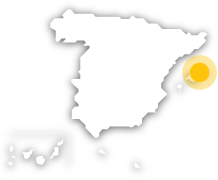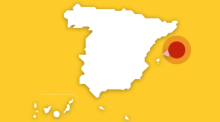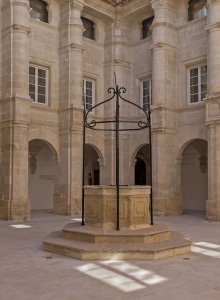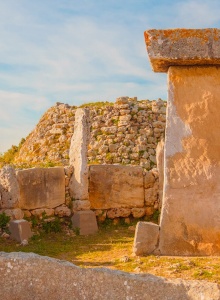Maó stretches along the shore of one of the best and largest natural ports in the Mediterranean Sea.
The capital of Minorca still preserves a number of churches, ancestral buildings and palaces, lining streets of deep Mediterranean flavour.
But Mahón is also the silent witness to the presence of many diverse cultures that populated it throughout history. In the outskirts, archaeological sites like Trepucó can be visited, where one of the best collections of prehistoric art in the island is preserved.Another thing that makes the capital attractive is, in addition to the neighbouring coves, its location next to the S’Albufera des Grau, I’lla d’en Colomi i el Cap de Favàritx Nature Reserve, one of the most important ecosystems in the Balearic Islands.Legend has it that Mahón was founded by Carthaginian general Magón, brother of Hannibal. However, one thing is certain: both the present site of the city and the rest of the island of Minorca have been settled, throughout history, for many different civilisations. There were human settlements in the Island as far back as 2000 BC, leaving an important archaeological patrimony, which include the Talaiots (tower-shaped megaliths) and the Navetas (funeral constructions in the shape of an upside-down vessel). Under the Roman Empire, from 123 BC, the city became very important strategically, so that in 73-74 BC Emperor Vespasian declared the colony of Mago (present Mahón) a municipality. With the arrival of the Arabs, the city would become a remarkable Mediterranean commercial port, until the Christian king Alfonso III conquered the island in 1287. Centuries later, in the 1700s, the city would regain its lost splendour, becoming the administrative capital of the island during British rule.The city Along the streets that make up the historic quarter of Mahón, a good number of bourgeois houses can be observed, as well as historic buildings, specially around the squares of Colón, Sant Francesc, Conquesta and Miranda.One of them, the central Plaza de España, gathers important monuments. The Gothic church of Santa María, for example, built in the 13th century and remodelled in the 18th century. In the exterior of the temple, the largest in the whole island, there is a slender belltower. Inside, you can admire a great nineteen-century organ, or enormous acoustic quality.Next to the church is the City Hall, a building also known as Sa Sala. The Renaissance façade is dominated by a great clock, brought by the first British governor, Richard Kane. Among the rooms in this building, the conference room stands out, which keeps a good number of portraits of famous city figures.The church of Carmen, located in the square by the same name, is another emblematic building in Mahón. This Neoclassic temple, erected in the 18th century, houses a beautiful Baroque cloister in its interior.The city also has some great places where one can take a pleasant walk. Carrer Nou, a pedestrian street, is marked by numerous selling local crafts. Further down, along the shore of the port, which stretches for more than five kilometres, you will find plenty of restaurants, bars and terraces. In the surrounding area of the port, you can visit the distilleries of Majorcan gin (a drink flavoured with juniper cones) that follow the traditional English method of production. The Museums of MahónThe church of Sant Francesc, old Franciscan convent of Jesús (17th and 18th centuries), presently houses the Museo de Minorca. You can learn more about the history and customs of Minorcan people through its different exhibition rooms. Of great importance to the cultural life of Mahón is the Ateneo Científico, Literario y Artístico (Scientific, Literary and Artistic Centre), which houses interesting collections of cartography, fossils and ceramics.In the southern part of the bay, visit the Army Museum, which occupies the old gunpowder store of the castle of San Felipe. The exhibition mainly focuses on the history of the fortresses of San Felipe and La Mola.Gastronomy and the outskirtsOn the outskirts of Mahón, there are some of the most important prehistoric archaeological sites on the island. A few kilometres south of the capital you can visit Trepucó, a primitive village that preserves one of the best taulas (a "T" shaped megalith) in the Balearic Isles. Other options include a trip to Torelló, where you will find the Paleochristian basilica of Es Fornàs de Torelló, or to the settlement of Talatí de Dalt, with a taula and a few Talaiots.The Minorcan coast has a number of significant tourist compounds. In the coast of Sant Lluís, south of Mahón, is Binibèquer Vell. Its construction follows the canons of traditional island architecture and it has beautiful beaches like Binidalí y Binisafúa.Along the southern shoreline are the seaside towns of En Porter Cove and Galdana Cove.Inland, the town of Alaior is very much worth a visit. In its historic quarter, the churches of Santa Eulàlia and San Diego, both from the 17th century, are quite significant. But the town is also known for its prehistoric monuments, like the megalithic tomb of Roques Llises and the Tower den Gaumes.The eastern coast of Minorca holds the principal damp area in the island, where you will find the Nature Reserves of S’Albufera des Grau, I’lla d’en Colomi and Cap de Favàritx. The park centre has a shallow lagoon, which is a perfect marine-bird observatory. The unusual natural environment of Minorca, in addition to its cultural life and sustainable socio-economic development, allowed the 1993 declaration of the island as a Biosphere Reserve by UNESCO.The most internationally famous sauce of all of Minorcan cuisine is, well, mayonnaise, made with egg, garlic and olive oil. Some of the most typical island dishes get their ingredients from the sea, like for example the lobster casserole and the cuttlefish baked casserole. For dessert, have a delicious cheese with the label Designation of Origin - Mahón.










